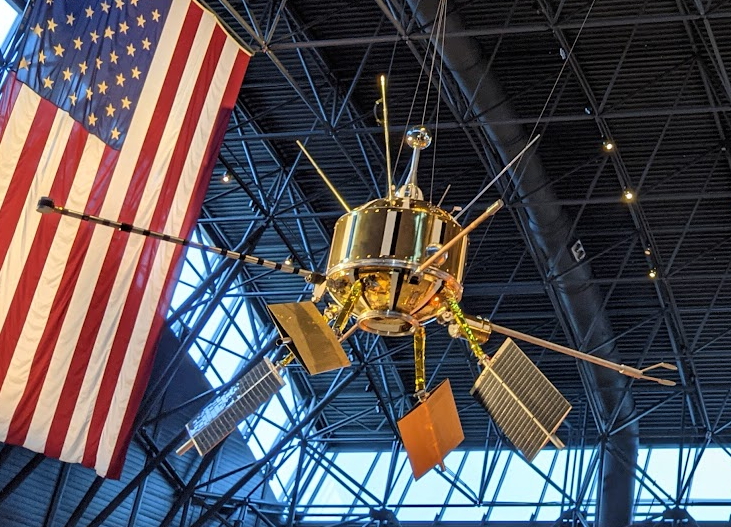As the Ukraine crisis continues to rage, the prospect of Russian nuclear weapons being used continues to trouble both the US and Europe. This was spurred in part by President Vladimir Putin’s decision to put Russia’s nuclear forces on high alert at the outset of the Ukraine conflict.
Washington Finally Confirms Its Plan To Equip Ukraine With APKWS II Laser-Guided Rockets To Battle Russia
In early March, Putin took the next step, conducting military drills with nuclear-armed Russian submarines and mobile missile troops.
In the wake of these nuclear tensions between Moscow and Europe, the United Kingdom recently marked the 60th anniversary of the deployment of its first satellite into orbit, which was incidentally ‘nuked’ by its ally, the United States, during a nuclear bomb experiment.
The Ariel 1 spacecraft marked its 60th anniversary on 26 April. This satellite was produced as a joint venture between the United States and the United Kingdom. London designed and produced the satellite’s core systems, and NASA put it into orbit using a Thor-Delta rocket.
Stab-In-The-Back For US? Are France & Germany Playing A “Double Game” In Russia’s War On Ukraine?
When NASA offered to let other nations launch their scientific instruments into space, UK scientists suggested the Ariel-1 proposal to NASA in 1959. Details were readily and rapidly ironed out due to the close friendship between the two countries.

By the next year, scientists in the United Kingdom had been permitted to begin developing the necessary instrumentation, and engineers in the United States had begun the development of the satellite that would accommodate the equipment. It was finally launched on 26 April 1962, making the UK only the third country to operate a satellite, after the Soviet Union and the US.
Its purpose is to analyze the impact of X-ray radiation from the Sun on the Earth’s upper atmosphere. The instruments aboard Ariel-1 were designed to “contribute to the current knowledge of the ionosphere” and its link with the Sun, according to NASA.
Ariel-1 was equipped with a tape recorder for storing data, a device to detect solar radiation, and various equipment to determine how the various particles in the ionosphere reacted and altered in reaction to external stimuli from the universe, most prominently the Sun.
On July 9, 1962, just weeks after Ariel-1 was sent into orbit and began sending data about the ionosphere down to Earth, British scientists were taken aback when radiation sensors onboard the spacecraft began to give outrageously high readings. They suspected the satellite’s instruments had broken or were otherwise malfunctioning at first.
The satellite eventually stopped operating. Its fall was no random occurrence: it occurred four days after the US military opted to test a 1.4 megaton nuclear weapon called Starfish-Prime in the upper atmosphere as part of Project Fish Bowl.
The explosion generated an electromagnetic pulse (EMP) powerful enough to impair worldwide radio communications and even knock out streetlights in Hawaii.
The explosion occurred roughly 400 kilometers (250 miles) over the Pacific Ocean, high in the sky. It emitted a powerful wave of radiation that destroyed several of Ariel-1’s systems, including its solar panels, and killed it.

Incident Locked Away For 50 Years
According to a BBC Future report, it is “clear why” the records were kept classified for so long. Although NASA promptly realized what had happened to the satellite, the UK was kept out of the loop.
Following an investigation, UK officials soon learned about the satellite, and Lord Hailsham, the then science minister, informed Prime Minister Harold Macmillan. “Although badly wounded in his solar paddles, he is not quite dead,” he writes in a two-page memo from 10 September 1962.
“He still utters intermittently – sometimes intelligibly. He may still improve sufficiently to tell us something of value, though he can hardly say ‘merrily shall I live now,” he said.
According to Hailsham’s memo, the UK’s financial loss from the projects was minor compared to the US, which put up the majority of the funds. He went on to say that the satellite had already proven its importance in terms of research.

He continued: “We have got a great deal out of him during his life (short, but neither nasty nor brutish).”
“Before his accident, he had transmitted for approximately a thousand hours, and it will take at least a year to analyze the significance of what he has said.”
The Starfish Prime nuclear explosion wreaked havoc on more than just Ariel 1. The test was also attributed to the early failure of Telstar, the world’s first television communications satellite.
Nevertheless, military planners were intrigued by the weapon’s impact following this incident. They pondered if spaceships could be damaged with nuclear or EMP weaponry.
This could also include interfering with an adversary’s communications, defenses, surveillance satellites, and a country’s ground-based electrical infrastructure, they warned.
EMP weapons are designed to be delivered by ground forces or aircraft and are capable of melting all electronic systems in a given area or targeting certain wavebands, such as destroying a nation’s radar defense systems.
Although governments and military strategists have expressed concern about this EMP technology, experts remain skeptical about it.
- Contact the author at ashishmichel@gmail.com
- Follow EurAsian Times on Google News




